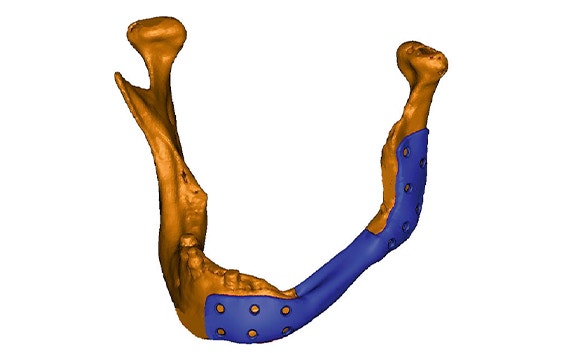PATIENT STORY
3D-Printed Personalized Implant Helps Patient with Ossifying Fibroma

Making the world a better and healthier place was certainly the goal when Materialise allocated a grant to the Centre for Rapid Prototyping and Manufacturing (CRPM) at the Central University of Technology in South Africa. The grant enabled the CRPM to carry out life-changing interventions and show students the benefits of medical 3D printing.
One of the patients helped by the CRPM was a young woman of 32. She suffered from an ossifying fibroma tumor in her lower jaw. The surgical team decided it was necessary to immediately resect the tumor and place a personalized laser-sintered titanium craniofacial implant in the patient’s mouth.


Although the ossifying fibroma was benign and painless, these types of tumors can grow to very large proportions if left untreated. The result is a tumor filled with cementum (the calcified substance that anchors the teeth to the jawbone), which mostly occurs on the lower jawbone.


The team started by taking CT scans of the patient and converting them into a 3D model in Materialise Mimics. The resulting 3D models of the bone and tumor were used as input to plan the resection planes and design the corresponding cutting guides. After virtually going through the surgery, an implant was designed to fit the gap perfectly. The guides and models were printed in plastic, and the implant itself was 3D printed in titanium.
The aim of this design was to fully cover the titanium frame and the bone around the dental implants with soft tissue. Because soft tissue does not attach itself to titanium, any exposure of the implant would lead to epithelial ingrowth around the implant. The result would be infection and eventually the loss of the implant.


The surgery was carried out successfully. By using the cutting guides, the titanium implant fit perfectly after the tumor had been resected. Just 24 hours post-surgery, the patient was already able to move her jaw normally again. In phase two of the process, the space maintainer was removed, and the cage was filled with bone harvested from the iliac crest. The third phase will see the placement of the dental implant into the augmented bone. In the final phase, a denture will be placed into the implant.


About the CRPM
The Centre for Rapid Prototyping and Manufacturing is part of the Central University of Technology (CUT) in South Africa. Established in 1997, the CRPM owns a range of 3D printing machines and technologies, including plastic laser sintering, direct metal sintering, and stereolithography printers. It is one of the best-equipped 3D printing facilities in the southern hemisphere.


Share on:
You might also like
Never miss a story like this. Get curated content delivered straight to your inbox.
